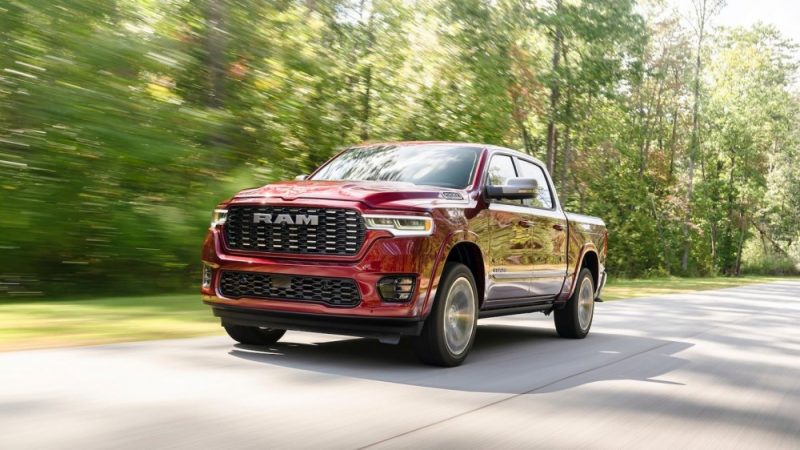The 2025 Ram 1500 pushes more power out of a smaller engine

Ask Merriam-Webster to explain the word “truck” and you’ll find this: “a wheeled vehicle for moving heavy articles, such as a strong horse-drawn or automotive vehicle (such as a pickup) for hauling.” Trucks are, by definition, made for work. However, that doesn’t mean they can’t be luxurious inside or improve their fuel efficiency, or even go with an all-electric powertrain.
Truck builder Ram is checking all those boxes with its newest iteration of its Ram 1500 pickup as a 2025 model. The 2025 Ram 1500 is offered in a choice of seven different trim levels: starting with the basic Tradesman featuring the brand’s tried-and-true V6 Pentastar engine to the top-of-the-line Tungsten with a new inline-six engine bolstered by two turbochargers, a 23-speaker Klipsch audio system, and more. Across the lineup, the new Ram 1500 includes an updated electrical architecture that communicates and responds faster, improving everything from the infotainment setup to the safety system.
And plug-in hybrid and all-electric versions of this truck are just around the corner.
Replacing the legacy V8
This generation of the Ram 1500 launched in 2019 with a brand new body style, and the brand kept the exterior mostly the same for 2025. It has a new grille and the word “Ram” is higher up on the grille, giving it a slightly taller impression. The real difference is under the hood, though. Ram dropped its traditional V8 powerplant, which is a big deal for this brand. Ford and Chevrolet still offer a V8 in their half-ton pickups, while Toyota ditched its V8 for a turbocharged V6 in 2022.
In place of the stalwart eight-cylinder engine, Ram launched its much-anticipated Hurricane. The Hurricane is an inline-six with two turbochargers in two flavors, standard and high-output, with a difference of 120 horsepower (420 hp versus 540 hp) and 52 pound-feet of torque (469 lb-ft versus 521 lb-ft) between them.
Ram isn’t rushing to replace its internal combustion options with all-electric trucks. The automaker’s emission goals are tied to its parent company Stellantis, which is aiming to cut its carbon footprint by 50 percent by 2030, reaching net zero by 2038. Meanwhile, Ram is focused on making its available powertrains as efficient as possible.
Doug Killian, the chief engineer for the Ram 1500, says that even as Ram was launching this generation for 2019, the team was already planning out and thinking about what the next evolution of the vehicle would look like. The straight-six has been in the works for several years.
“We had the straight-six turbo in development and worked on making it more refined, giving it more power, better emissions, and better fuel economy,” Killian explains. “We don’t just launch a truck and then stop; we’re constantly thinking about what’s next.”

Two engines, three flavors
The naturally aspirated V6 is part of a mild hybrid system Ram calls eTorque, which was previously present on the V8. In contrast, the Hurricane is not a hybrid but uses turbochargers; two sets of three cylinders are each fed by a turbo. With the inline layout, each turbo can be a little smaller with less rotational inertia, Killian says. As a result, the turbos spool up faster with less rotational inertia, reducing turbo lag to the point it’s nearly unnoticeable.
“We planned these powertrains and propulsion systems with an inline arrangement, which makes room for the twin turbos on the side of the engine,” Killian says. “The inline-six arrangement gives us more packaging opportunities than the V arrangement would.”
In competing trucks, like the Toyota Tundra and Ford F-150, the torque numbers are higher than the horsepower; not so for the Ram 1500.
“In this case, the turbos develop torque at a little higher rpm,” explains Killian. “And we’ve designed the engine so that the bore-to-stroke ratio uses a longer stroke, which gives more power.”
Why keep the Pentastar now that the Hurricane is finally here? Killian says the V6 has a lower power output than the Hurricanes and it will have slightly better fuel economy. The Pentastar offers a lower-cost option with a lower power level, while the twin-turbo Hurricane represents what Killian calls an “extremely advanced” engine. It’s akin to selecting a Dodge Charger; the value option is the basic four-door Charger with adequate power or choosing the one with a screaming 700-hp-plus Hellcat under the hood.
“Even though the displacement is lower on the Hurricane engine, it has these twin turbos which add a lot more power,” Killian says. “That intake effectively increases the displacement when you need the power.”
On- and off-road testing confirms Ram’s claims. The new Ram 1500 feels even more capable than before, and the smooth torque of the high-output Hurricane provides a thrilling burst of power on the dirt. Ram did away with its high-performance 1500 TRX and will be replacing it with the new off-road-oriented RHO later this year. We can’t wait to try it.










